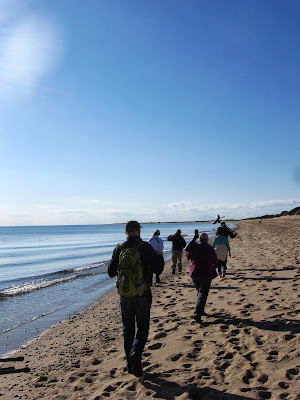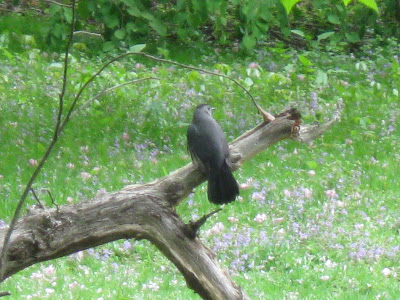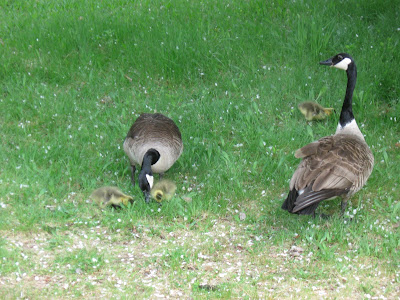 |
| Pink Lady Slipper is a species of orchid found growing in semi-shaded woods throughout Massachusetts. Image copyright Daniel E. Levenson 2013. |
Although birds are often a featured subject of this blog my interests in the natural world also extend far beyond our feathered friends. As we come to the end of spring and move toward summer I also plan to write about the reptiles, amphibians, mammals and insects I come across in my outdoor adventures. As someone who tries to look at not just the constituent parts of different habitats but how they all fit together into larger ecosystems, I am also deeply interested in the plants and plant communities which anchor these habitats, often providing the food, shelter and other resources that creatures from Bark Beatles to Beavers need to survive.
 |
| Milkweed is a commonly seen plant native to New England and is an important source of food for butterflies. Image copyright Daniel E. Levenson 2013. |
I also love the idea of gardening and landscaping in suburban environments which not only encourages local wildlife to visit backyards, but also places an emphasis on native plants and perhaps restoring a little wilderness to the otherwise drab uniformity which has come to symbolize many of the yards and parks in our cities and towns. In today''s post I would like to share some links to online resources where you can learn more about native plant life in New England and perhaps suggest a few ideas which might make your backyard more enticing to wildlife. Please note that mention below of any specific business or organizations should not be taken as an endorsement.
A home for butterflies and moths
Everyone loves butterflies - these brightly colored creatures are sure sign of spring and summer, lending vitality to any garden. There are also many beautiful moths that can be found frequenting open meadows and city parks. I have seen several purpose-built butterfly gardens over the years and always been impressed with the variety of native plant species growing in them. if you would like to attract butterflies to your yard in Massachusetts you might want to visit the website of the
Massachusetts Butterfly Club
which also features a dedicated section on
creating and maintaining a butterfly garden.
 |
| An Eight-Spotted Forester Moth (Alypia octomaculata) takes a break at Moose Hill Wildlife Sanctuary in Sharon, MA. Image copyright Daniel E. Levenson 2012. |
If you live in northern New England you may want to check out this website from the University of Maine on
how to create a welcoming environment for these colorful insects. This site also features an overview of the life history of butterflies, some very nice photos and lists the families commonly found in the state, including swallowtail and monarch. if you're looking for some inspiration, you can also check out this article written by
Aislinn Sarnacki in the Bangor Daily News, where
she describes a number of butterfly gardens that people have created in and around Bangor, Maine.
Putting out the welcome mat for our amphibian friends
Frogs, toads and salamanders are an integral part of a variety of different kinds of New England, they also provide a valuable service by eating many thousands of pest insects every year. They can also be great to look for, as finding them usually requires slogging around in marshes, turning over rotten logs and all kinds of other joyous muddy activities.
 |
| If you would like to attract frogs to your yard your best bet is to create a frog-friendly pond with plenty of cover, a sloped bottom and no fish. Moving adult frogs or tadpoles is often not a good idea - if you create the right environment, and have patience, experts say the frogs will eventually find the home you have built for them. Image copyright Daniel E. Levenson 2013. |
If you would like to have more of these creatures in your yard or garden you might want to consider trying to entice a toad or two to settle nearby. This nice website from the
National Wildlife Federation notes that "The U.S. Department of Agriculture estimates that
a single adult toad can eat 10,000 insect pests over the course of an average summer." That's a lot of bugs. The site also offers great tips on how to create a home for toads and encourage them to make your yard their home. The site also offers
advice on ways to make your property more attractive to frogs as well, with advice on avoiding the accidental introduction of alien invasive species, building a frog-friendly pond and the type of plants which are likely to attract these amphibians. Leaving stumps and rotting logs at the edge of your yard or in place on wooded property will also provide an important source of food and shelter for salamanders.
Bring on the birds
Of course there are many ways to make your property more attractive to birds, from providing a source of freshwater with a small pond or birdbath to putting up feeders. For long term success I think it is also very important to think about the kinds of flowers, trees and shrubs you plant on your property. This
document from the Cornell University Lab of Ornithology offers some great tips on how to approach the design of a bird-friendly yard or garden from the birds' perspective. It includes concrete suggestions on different types of plants and trees to consider, different kinds of habitat you can create on your property and suggestions for further reading.
Creating space for the plants themselves
In addition to planting certain species to attract more wildlife to your yard there is of course great value in creating space for the native plants themselves to thrive. While you should never collect native plants or flowers from the wild and transplant them to your own property, there are a number of organizations and garden clubs which run native plant sales throughout the spring, including one on
Saturday, June 1st and Sunday, June 2nd, at Mass Audubon's Moose Hill Wildlife Sanctuary in Sharon, Massachusetts. According to the Mass Audubon website, plants for sale will include: "Mayapple, Turk's Cap Lily, Cardinal Flower, Canadian Ginger, Lowbush
Blueberry, Spicebush, Mountain Laurel, Purple Joe-Pyeweed, Black-eyed
Susan, Purple Coneflower, Swamp Milkweed" and others.
If you're looking for general information and inspiration when it comes to learning more about native plant life you can check out the website of the
New England Wild Flower Society, an organization dedicated to the protection, propagation and promotion of native plans. The society also runs
Garden in the Woods, a large garden and education center open to the public, located in Framingham, Massachusetts,where visitors can see more than 100 rare or endangered species of plants. To learn more about endangered and protected species of plants in Massachusetts, you can also visit this nice website from the
Massachusetts Division of Fisheries and Wildlife. In addition to a comprehensive list of the species concerned a fact sheet is also provided for many of them.
Well, I think that about covers it for now. As I continue to learn more about gardening for wildlife and the native plants of New England I will share these experiences, along with my other adventures searching for birds, kayaking, camping, hiking and exploring, here at the New England Nature Notes blog.
Thanks for reading.
Copyright Daniel E. Levenson 2013.




















































